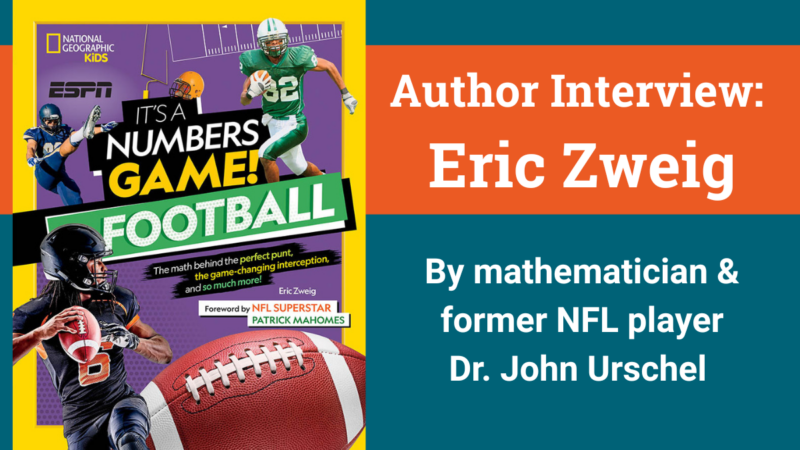By Dr. John Urschel
Co-Chair of the Mathical Selection Committee & Assistant Professor, Department of Mathematics at Massachusetts Institute of Technology (MIT)
Mathical Book Prize Co-Chair Dr. John Urschel is Assistant Professor of Mathematics at MIT and former offensive lineman for the NFL’s Baltimore Ravens. Recently, John talked with a fellow Canadian, author Eric Zweig, about his Mathical Honor Book It’s a Numbers Game! Football.
John Urschel: Which came first for you, a love of sports, a love of writing, or a love of math?

Eric Zweig: For sure, for me, it’s love of sports first. I can’t really remember a time when I wasn’t crazy about football and hockey. (Baseball came later, but it became my favorite sport.) I’m sure part of it was because my father and mother were sports fans. All my older cousins too. I went to my first NHL hockey game when I was seven years old (in December of 1970) and to my first football game in 1971 when I was still just seven. When I visit schools to talk about my books, I tell them that it was really in September of 1972 (about six weeks before my ninth birthday), when Team Canada faced the Soviet Union in what has become known as The Summit Series — perhaps the biggest event in Canadian sports history — that I truly became a sports fan for life.
As for math, I was always pretty good at adding, subtracting, multiplying, dividing, and even fractions … but by high school, math was pretty hard for me. Still, I think being able to compute batting averages in baseball, and goals-against averages in hockey was what made math seem useful for me!
I was never great at school, and I was not one of those kids who always wanted to be a writer. But when I was a teenager, I would sometimes write sports stories about the games my brothers and I would play. As I got older, I realized that my ideal job would be something in sports. I wasn’t good enough as a player. Maybe I should have gone to school to be a broadcaster. Instead, I just started writing about sports.
What do you love about numbers and sports?
Eric: When I was younger, I would say I just loved the competition in sports. I wasn’t super competitive myself, but I guess I liked that you never really knew who would win — even if one team was better than the other — and just watching to see how it all came out. As I got older, I really learned to love the history of sports. Where the games got started. How. Who the great early players were. Numbers became important because of sports statistics. Who scored the most goals? Who ran for the most yards? Who hit the most home runs? I used to love getting the season preview magazines for baseball when there was still snow on the ground where I lived and looking at the all-time leader boards and seeing who might reach important statistical milestones in the coming season!
How did you research the history, rules, and statistics of the sport? Did anything surprise you?
Eric: I love the history of sports! I have lots of books about sports history. And these days, there are tons of web sites too. For me, doing the research is the best part of writing a book! I mostly write about hockey, so it was a lot of fun for me to dig into the history of football for this book because it was something different. One story I found (it didn’t end up making it into the book!) that I really liked was about a college football player at Princeton who kicked a very long field goal back in 1882. The stories said it was at least 65 yards long. I was amazed that someone could kick a football — especially those big, old, heavy-looking footballs — so far such a long time ago.
Like I said, the story didn’t make it into the book, but I used it on my website: http://ericzweig.com/2019/10/15/working-hard-or/
What surprised you most when writing the book?
Eric: I’m not sure that anything really surprised me. I was a little nervous about the math in these books. Before I got started, the editors told me not to worry, statistics would count as math and numbers. That was good! Statistics are easy! But then I would write something like, “a football game is made up of four quarters that are 15 minutes long.” The editor would suggest changing it to “If a football game is made up of four quarters that are 15 minutes long, how many minutes is that in total?” Made sense … but I had to wrap my brain around thinking about things in that way!
If you could share an insight about math & football with a young person, what would it be?
Eric: Before I wrote this book, I hadn’t really thought about how much math and science was involved in football. I knew there were lots of numbers. Numbers on the field. Numbers on the scoreboard. Numbers on the jerseys. Lots of statistics too. As I was writing the book, I had to think about the math and science involved in throwing or kicking a ball. I don’t know how much players think about that. It’s not like they run out onto the field with protractors to measure the proper angle! It’s just something they learn to do naturally as they grow up playing the game. How much force to throw (or kick) this ball that far? How much time do I have to make this play?
So, I loved what Patrick Mahomes [quarterback of the NFL’s Kansas City Chiefs] wrote in the forward to the book: He talked a lot about time and about statistics, but he also said: “… there are a lot more numbers in football besides the time on the clock. Numbers help tell the story. Math is in every play, from calculating the down and distance of a drive, to adding up how many yards I need to throw a complete pass to a receiver, to the angle that the receiver cuts in a pass pattern to catch it.”
If you’re a kid who loves math, but not sports so much, see if you can find the math hidden in the way a game is played. And if you’re a kid who loves sports, but not math so much, I hope this book (and the others in the series) help you realize there’s a lot of math going on in the games you love to play and watch!
About It’s a Numbers Game! Football
Do you know how to calculate a quarterback’s completion percentage? What was the score of the highest scoring Super Bowl game? Become a football fanatic and learn all about the numbers and math behind this popular sport.
With every throw, tackle, and kick, numbers are being calculated on the football field. Get ready to learn all the ways digits and math factor into the game, from the countless statistics used to measure an individual player’s performance to the numbers used in defensive formations. Read about the greatest players from football history and get fascinating facts, like the price of a Super Bowl commercial. Discover which NFL team defenses have allowed the fewest points and check out cool graphics that show the angles in different pass patterns.
Jam-packed with sports trivia, awesome photos, and fun activities at the end of every chapter, this number-focused look at the game is a definite touchdown.
About the Author: Eric Zweig
Eric Zweig is a freelance writer and sports historian. By the age of ten, Eric was already a sports fanatic who was filling his school news books with game reports instead of current events. He has been writing professionally about sports and sports history since graduating from Trent University in 1985. As a freelance writer, Eric is the author or co-author of many non-fiction sports books for adults and children. He has also been an on-air guest on dozens of television and radio programs. He lives in Owen Sound, Ontario, Canada. Learn more at his website: http://ericzweig.com.
